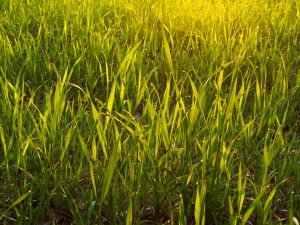Overseeding a lawn is another way to keep weeds to a minimum if you didn’t apply pre-emergent. The following is what you should know before you start slinging seeds.
First, do not overseed St. Augustine grass, ever. Opinions vary on if you should overseed Zoysia. The following applies to Bermuda grass only. You only use ryegrass for winter overseeding. Know how many square feet you want to over seed. Remember, you will have to mow during the winter. Sometime in March or the beginning of April, you will need to scalp the lawn. Set the mower to its lowest setting then mow and bag the lawn. Scalping will remove dead Bermuda (thatch), ryegrass, and most of the weed seeds that survived the winter and allow the sun to warm up the soil. That last part will bring Bermuda out of dormancy faster.
There are 3 distinct types of ryegrass:
- Annual rye is the cheapest. It grows very fast and is very moist and tends to be a pale green. It works great for livestock and erosion control. It is my least favorite overseeding grass for lawns. Depending on the weather, it dies out towards the end of May.
- Perennial rye is the most expensive but also the best looking. It grows slowly and is dark green. Because it will last longer than the annual rye, scalping is a must if you want Bermuda to come back before the end of June. Even though it’s called perennial if you get 10% of it to come back next year you hit a home run.
- Transitional rye is the middle ryegrass. It falls between annual and perennial in price, color, and growth rate. Scalping is still required for the proper growth of Bermuda.
I recommend transitional or perennial over the annual. Several years ago the trend was to overseed with fescue grass. Only fescue should be overseeded with fescue. Application rates for overseeding with ryegrass fall between 5# – 10# per 1000 sq. ft.
Questions about overseeding your lawn? Give us a call or stop by the store and talk with our experts.






